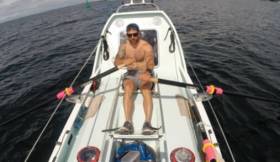Displaying items by tag: Gavan Hennigan
Hennigan Fights Winds to Protect Third
#Rowing: He has new rivals for his placing, but Gavan Hennigan remains in the top three of the Talisker Whisky Atlantic Challenge. Facing It, a South African trio have taken over from American Oarsmen, also a trio, in fourth place. As the winds change, Hennigan’s progress has been a little slower than in recent days. However, as of midday on Wednesday, Facing It were over 60 nautical miles (over 110 km) behind the Irish solo rower on the row from the Canaries to Antigua. “Busy cementing third and working hard to stay there,” was Hennigan’s comment on his site, gavanhennigan.com.
Atlantic Rower Hennigan Defies Winds to Hold Third
#Rowing: On the 15th day of his solo row across the Atlantic, Gavan Hennigan has firmly established himself in third in the Talisker Whisky Atlantic Challenge. The winds have picked up and he reports some difficulty – “oars trying to take my head off” – but he is covering impressive distances, including 70 nautical miles (130 km) in a 24-hour period. He took advice from his mentor, Henry Lupton, on the prevailing winds at this time of the year and chose to take a route well south of the rhumb line (most direct line) from La Gomera to Antigua. It seems to have worked well, and the Galway man is adjudged to be 29 nautical miles (54 km) closer to the finish line than his rival for third, American Oarsmen, a trio. Latitude 35, an American four, are the clear leaders, from British four Row for James. There are 12 boats in the race: three fours; three trios; two pairs and four solos.
#Rowing - Galway man Gavan Hennigan aims to join an elite group of rowers who've crossed the Atlantic solo when he takes part in the gruelling Tallisker Whisky Atlantic Challenge later this year.
Not to be confused with the Atlantic Challenge for longboats, the Tallisker Whisky Atlantic Challenge is a 3,000-nautical-mile rowing route across the world's second-largest expanse of ocean from the Canary Islands to Antigua in the West Indies.
Described as "horrific" by Seán McGowan, the first Irish person to complete the route six years ago, it's a challenge that's not for the faint of heart.
And 'extreme environment athlete' Hennigan is making it even tougher for himself by heading out solo among a field that usually features teams of up to four.
But the experienced adventurer – who hopes to raise €20,000 over the coming months for charities including Cancer Care West, Jigsaw, Sanctuary and the RNLI – is taking it all in his stride.
"I suppose I like the idea of the challenge," he told the Galway Independent. "I’ve spent a lot of my time in extreme places doing mountaineering in the Himalayas, I’ve been to Antarctica, I’ve done some of the world’s longest and toughest ultra-marathons.
"I’ve also had one of the most dangerous jobs in the world as a commercial diver so I’ve lived this life of extreme adventure and this just looked like the next big challenge for me."
The Galway Independent has more on the story HERE.































































